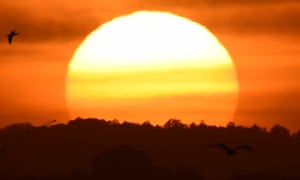Temperatures reach into the mid-40s in some parts of Australia
Much of Australia is in the grip of an extreme heatwave with temperatures reaching into the mid-40s and total fire bans in force in parts of South Australia, New South Wales and Victoria.
South Australia followed up a scorching Friday with a similarly warm Saturday, with temperatures hitting 46C in Port Augusta and Coober Pedy.
An extreme bushfire risk was declared for the Adelaide Hills. On Friday, a grassfire north of Adelaide burnt through 650 hectares.
The state’s Country Fire Service advised those in the at-risk districts to put their bushfire plan into action and keep track of any updates.
In the town of Coober Pedy in northern South Australia, where the temperature hit 46C on Saturday, about two-third of residents live in underground dug-outs.
“Whilst people in dug-outs will be fine today, we really are concerned about the people that live above ground in housing, in houses above ground and also people that are visiting from other parts of the state, particularly from up north,” the Coober Pedy district council chief executive, Dean Miller, told the ABC. “We’ll be looking out for people to make sure they stay hydrated and have access to water and shade.”
In the state of New South Wales, temperatures exceeded 40C across the west and in coastal areas on Saturday.
Most of Sydney, including the CBD, recorded temperatures of 40C on Saturday as strong north-westerly winds held back the sea breeze. The highest-recorded temperature was at the airport, at 41.7C.
The Bureau of Meteorology manager Jade Golding said November records for warmest overnight minimums in some parts of NSW likely tumbled on Friday night, while daytime records could also fall this weekend.
NSW and Sydney would swelter until at least late on Sunday afternoon, when a gusty southerly was expected to cool temperatures for Monday.
“It’ll be a really long, uncomfortable night (on Saturday) and then a really long hot day and then a really windy southerly change,” Golding said. “The body doesn’t really get much respite, it’s quite hard.”
Temperatures across NSW would then spike again on Tuesday as heatwave conditions enveloped inland areas.
Golding said the weekend swelter would likely spur bushfire concerns, with the Rural Fire Service forecasting severe danger across southern NSW regions on Saturday including the Riverina. She said fires would be fuelled by strong grass growth over a rainy winter.
The RFS issued a total fire ban for most of eastern and north-eastern NSW for Sunday, including Greater Sydney, Illawarra, the Hunter and north coast. No fires would be permitted out in the open.
One 416 hectare blaze at Myrtle Park, east of border town Deniliquin, was downgraded to “advice” level after being brought under control on Saturday afternoon. The RFS’s large air tanker was on scene to assist firefighters.
The RFS deputy commissioner, Peter McKechnie, urged residents to have a fire plan ready and prepare their properties.
“This is the first time since the devastating season last year we’ve seen widespread elevated fire danger,” he said. “Know what to do if a fire threatens you, know where you’ll go.”
North-west Victoria also felt the heat, with temperatures in Mildura on Saturday reaching 45C – its previous record for November was 45.5 in 2012. Swan Hill was forecast to hit 44C and Echuca was expecting 42.
The state’s Country Fire Authority declared fire bans for the Mallee, Wimmera and northern country regions. Gusty winds were also forecast for Saturday, particularly in the north-west, plus thunderstorms in the afternoon and evening.
“The Mallee district will reach an extreme fire danger rating for the first time this season due to the forecasted gusty winds and increased grassland curing in the area,” the CFA acting chief officer, Alen Slijepcevic, said.
“Northern country and Wimmera will also experience elevated dangerous fire conditions, with a severe fire danger rating.
“As a result, we have declared a total fire ban across all three weather districts.”
In south-east Queensland, the heatwave was expected to last into mid-next week.
Reinforcements were being sent to the state’s Fraser Island to help contain an out-of-control bushfire that has been burning for the past six weeks.
Tourists were ordered to stay away from the blaze, which had burned through 74,000 hectares so far, and stay off the island’s inland tracks and roads.
Hotter, drier winds with the potential to carry the fire in a southerly direction were forecast over the weekend.
The blaze is believed to have been started by an illegal campfire on 14 October.
Last summer’s bushfires in Australia destroyed 2,476 homes, claimed 26 lives and burned 5.5 million hectares of land.

No comments:
Post a Comment